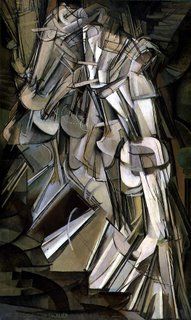Marcel Duchamp: spatial illusions
Cubism consructed new ways of seeing through spatial illusion. The cubists employed an analytic system in which the three-dimensional subject (usually still life) was fragmented and redefined within a shallow plane or within several interlocking and often transparent planes. The cubists sought to show everyday objects as the mind, not the eye, perceives them—from all sides at once. The geometric forms and compressed picture space in his paintings appealed especially to Braque, who developed them in his own works.
Duchamp's Nude Descending a Staircase was among the earliest attempts to depict motion using the medium of paint. Its conception owed something to the newborn cinema, and to photographic studies of the living body in motion, like those of Marey and Muybridge.
It was also an antidote to Cubism’s greatest weakness: Cubist paintings were invariably static. Instead of portraying his subject from multiple views at one moment, as Cubist theory would dictate, Duchamp portrayed her from one view at multiple moments, as Muybridge did. By turning Cubist theory upside-down, Duchamp was able to give his painting something the Cubists could not: vitality.
Duchamp said the swift nudes were “flights of imagination” introduced to satisfy his preoccupation with movement. They can also be seen as flights of imagination on the part of the king and queen — which makes this painting, like The Chess Players of 1911, about portraying thought. There is a greater degree of depth than in the preceding paintings, but margins between foreground and background are indistinct. As the eye moves around the canvas, its forms fluctuate in and out, change contours, and shift positions. This is a picture of complicated flux.

<< Home